Welcome to Part Two of the 2019 Small Business Website Teardown Report from Fresh Chalk. In this chapter I delve into the tricky world of small business website builders, hosting and site speed. Prepare for a deep dive into Squarespace, Weebly and Wix, with a bit of WordPress thrown in for good measure. I will show which website builders have the best SEO out of the box, which providers have the fastest websites, and whether or not digital marketing firms like Hibu and Thryv create decent websites.
This analysis is specifically focused on speed, google rank, and market share for the big website providers.
For more context, you should read Part One of the report, where I answer important questions like What is This All About and Why and How.
Key Findings
- Wix is the most popular website builder for small businesses with 21.6% market share. Unfortunately, Wix sites are super slow and tend to rank poorly in Google web search.
- Squarespace doesn’t have quite as many users as Wix, but the median Squarespace site outranks Wix by 13% in Google web search.
- GoDaddy Website Builder has a high market share overall, but looks a bit weak in more progressive cities like Boston, Portland and Seattle.
- Google My Business websites are blazingly fast, 61% faster than those pokey Wix sites.
- WP Engine sites significantly outrank all other website builders in Google web search, correlating with a 23% boost in rankings compared to the average small business website. A strong choice if you want to use WordPress.
- Digital marketing agencies Hibu and Thryv charge a premium for SEO, but don’t do any better than Squarespace in Google web search.

The Report is Ongoing
I’ll publish the next chapter in a few weeks. If you’ve got feedback, I'm @adamdoppelt. Let me know if there’s more you’d like to see from this report.
Published
1. SEO
2. Website Builders, Speed and Google Rank (this chapter)
3. Wordpress
On Deck
4. The Verticals - Real Estate, Auto, Vision, Chiropractors...
5. Social
6. Technical Factors
I Am About to Baffle You
Website building is a complicated subject. There are several important ingredients for a website: the physical server that hosts the website and makes it available online, the software that serves the underlying structure for the website, and the content that brings the site to life with text and images. These three ingredients might be provided by the same company, but not always. For example, it’s common for a small business to hire a digital agency to create a WordPress site hosted on GoDaddy.
What is a Website Builder?
There are three common ways for small businesses to build websites. In this report we’ll analyze three ways to build a website:
- Drag and Drop Builders - Drag and drop builders are powerful tools that anyone can use to create a website. Examples include Squarespace, Wix, Weebly, and GoDaddy Website Builder, as well as more specialized platforms like Google My Business or Shopify. These tools power the website from top to bottom and aim for ease of use.
- Popular WordPress Hosts - Companies like WP Engine and WordPress.com make it relatively easy to create a sophisticated WordPress-powered website. I analyzed a few of the big WordPress providers that are popular with small businesses and agencies. WordPress hosting in general is a rich topic that will be the focus of the next chapter.
- Digital Agencies - There are a pair of digital agencies which power a huge number of small business websites. You may not have heard of Hibu and Thryv, but they are behind a sizable chunk of the small business ecosystem.
This report digs into the ranking, speed, and performance for the providers listed above.
Note for industry experts: I don’t address cloud providers, dedicated machines, or shared hosting since small businesses don’t typically deal directly with those services. It’s impossible to evaluate ranking or performance for low level hosting since each machine is running different software. I actually collected a ton of data here but I don’t think it belongs in this chapter.
Check out the Methodology section below for more details.
Winners and Losers
Out of the gate, we found ninety website builders with significant market share across the 150k small business websites. Let’s take a look at the major players:
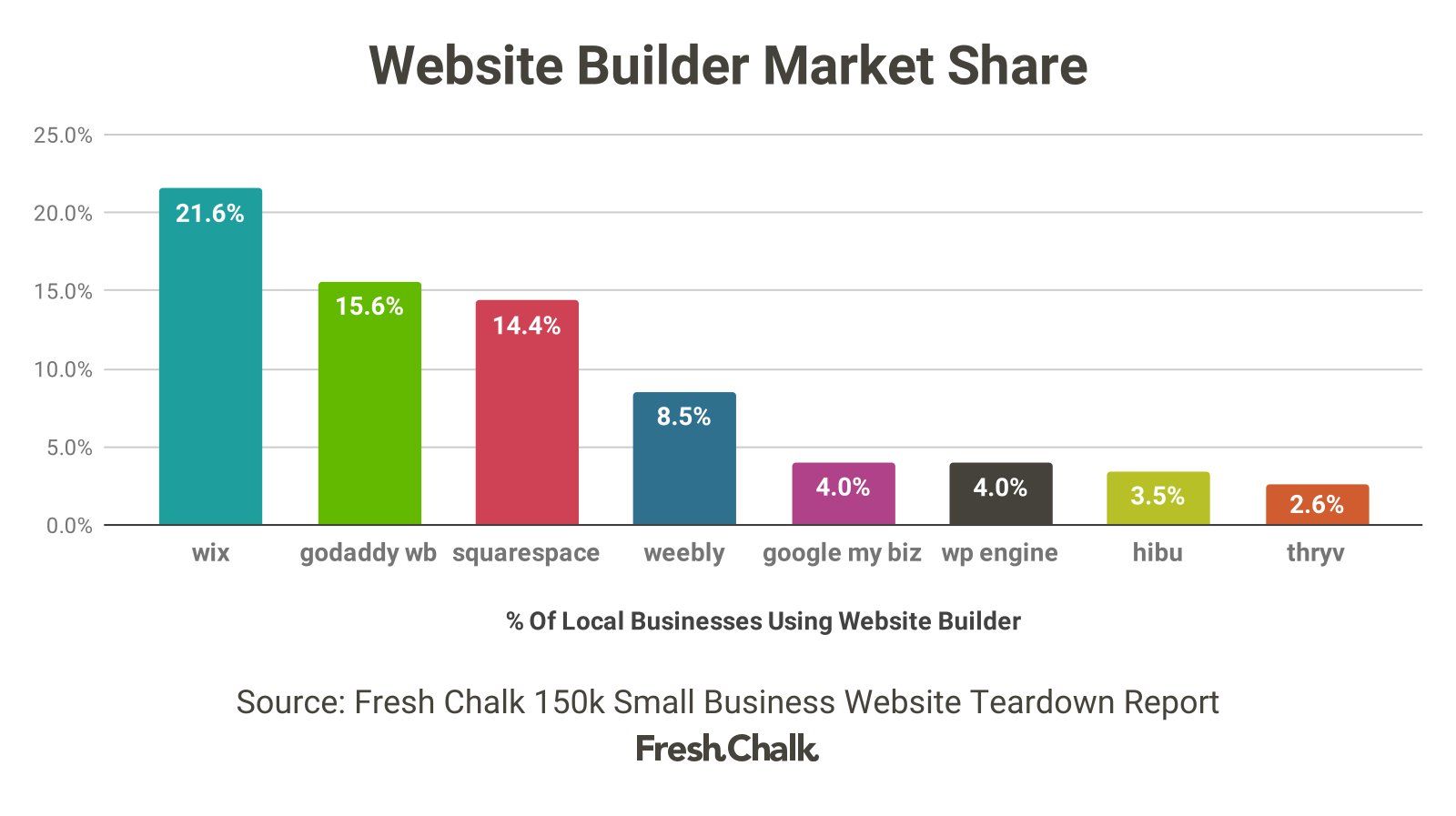
Wix is the clear market share leader for small business websites according to my data. GoDaddy and Squarespace are fighting it out for #2. Keep in mind that the GoDaddy column refers specifically to websites built with GoDaddy Website Builder. I included Hibu and Thryv to show how these giant agencies with their own proprietary website technology stack up against mainstream website builders.
Google My Business is the questionably-named Google feature where local businesses can add their contact info and photos to Google, and users can write reviews. Businesses added to Google My Business usually show up above organic search results. It turns out that local businesses can also use Google My Business to create a simple website with a few clicks. Using the unstoppable might of their search monopoly, Google My Business catapulted themselves to 4.0% of SMB website market share in the two years since its launch. Separately, keep in mind that Google is already using their monopoly power to dangle tantalizing Google My Business links above the organic search results.
Market Share By City
You may recall from Part One that our list of small business websites comes from Fresh Chalk. In addition to the website, we also know the city for each business studied in the report. How are the popular website builders doing in each of our cities?

These numbers largely line up with the overall market share picture, but there are a few surprises. Squarespace is relatively weak in Houston and surprisingly strong in Portland - perhaps because of their large engineering presence there.
Meanwhile, GoDaddy seems to be weak in progressive cities. In Boston, Portland and Seattle people might be more sensitive to the hijinks of their trigger happy ex-CEO and their sexist ad campaigns of yesteryear? Just speculating here.
PageSpeed Score
Website performance matters, which is why Google factors site speed directly into search rankings. Speed is actually becoming more important over time, not less. Mobile users tend to abandon websites that are slow to load over pokey cellular networks.
Google provides the PageSpeed tool to help website owners measure the performance of their website. PageSpeed uses a customized version of Chrome to fetch a web page and measure a variety of esoteric metrics such as first meaningful paint and total number of requests. Those of us who care about performance go crazy for these stats. They also roll all the metrics up into a simple 0-100 score. You can try it out yourself.
Google provides a handy API, which I exercised ruthlessly to gather stats for the popular website builders:
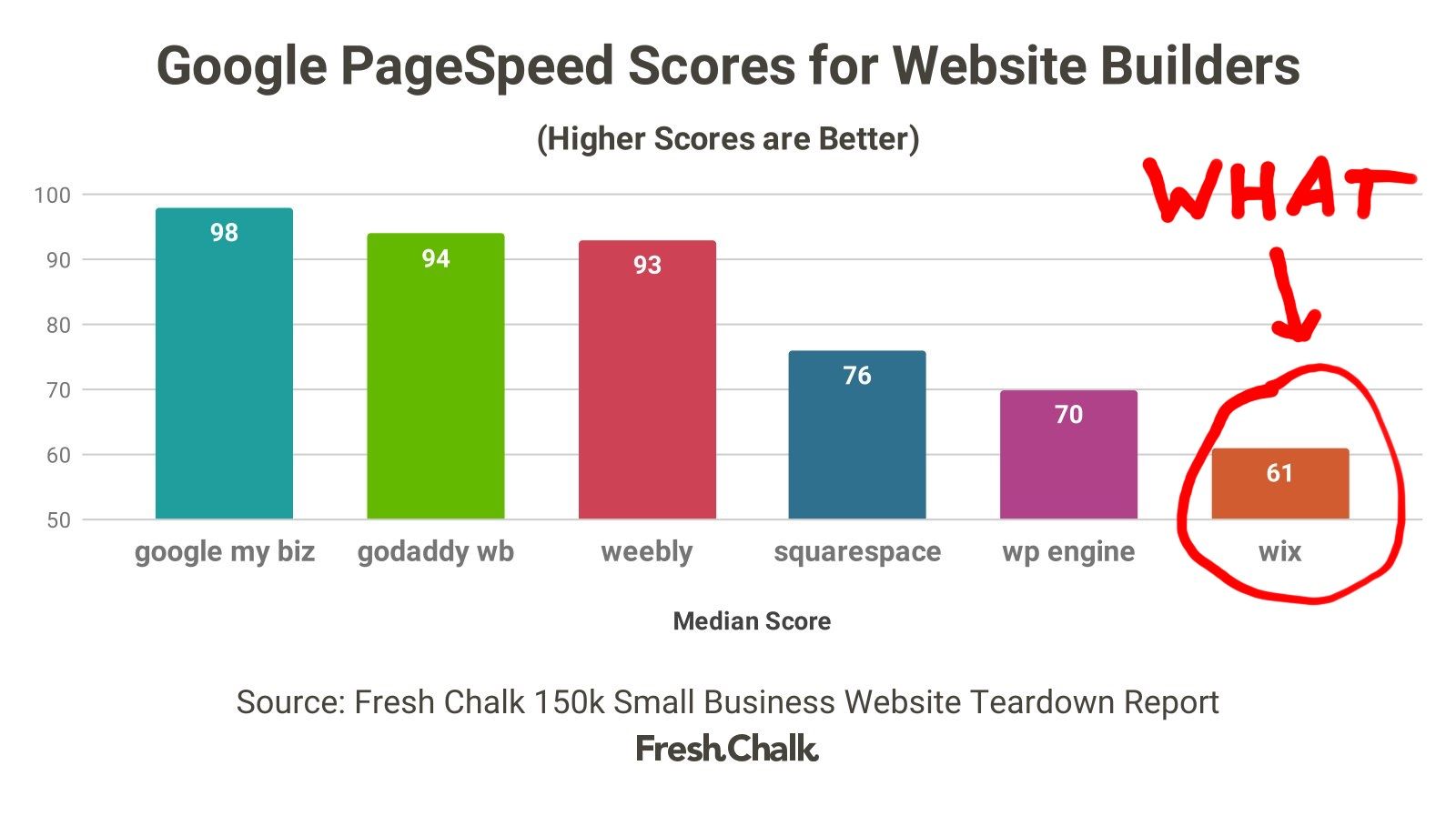
Unsurprisingly, Google is crushing it at the metric that they devised and encouraged the rest of us to adopt. GoDaddy Website Builder and Weebly are strong performers as well.
Wix is tanking. But remember, Wix has the largest market share of any website builder! That’s a terrible dynamic.
How is it that Wix performs so badly here? PageSpeed tells the tale. The most heavily weighted component of PageSpeed is the interactive metric, which measures the initial delay before a user can interact with a website. Wix takes around 4.2s to become interactive, vs 1.4s for Google My Business. Probably because loading a Wix website forces your web browser to make 137 total requests versus the 39 required for Google My Business. Ouch.
This abundance of requests slows things down and negatively impacts how users perceive the business. Knowing that users prefer a speedy website, Google uses page speed as a ranking factor and feeds these scores directly into the SERPs.
Here are the PageSpeed scores for up and coming small business website providers:

The First Nibble
As part of my website crawl, I also recorded the time to first byte (TTFB) for each of the websites. Time to first byte indicates how long it takes the web server to return the very first chunk of HTML when a web browser requests the web page. This isn’t a direct ranking factor for Google but it’s an important measure of speed. How do the big platforms compare?
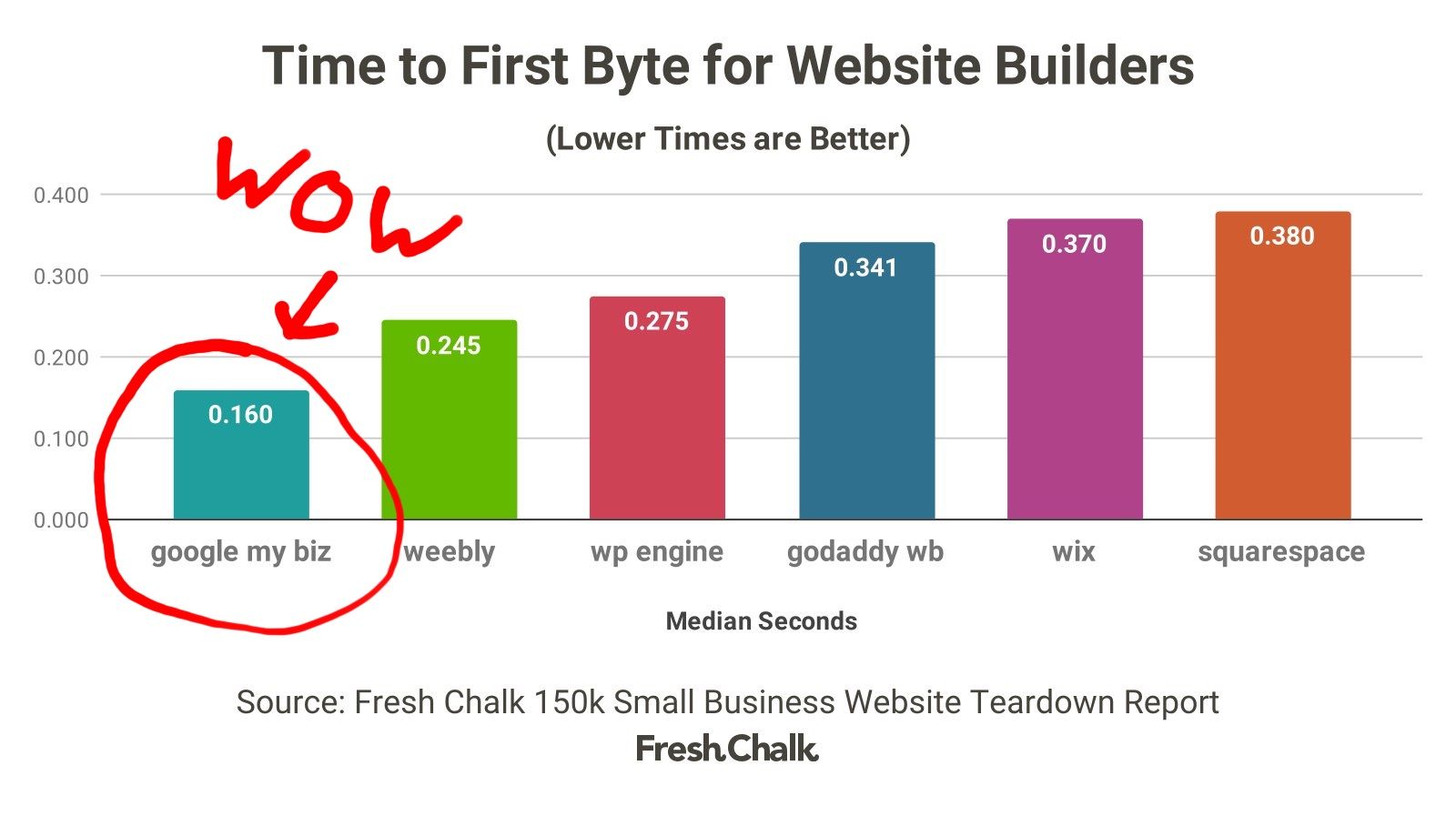
Google My Business is the fastest by a large margin. I’m not surprised. Google has a reputation for speed, and the cookie cutter websites offered by Google My Business are quite simple. Weebly and WP Engine lag behind. Meanwhile, GoDaddy Website Builder, Wix and Squarespace are bringing up the rear by a large margin.
Once again, a website builder’s market share does not mean a speedy website!
What if we look beyond the big six? Here are the stats for the next set of providers with decent market share:
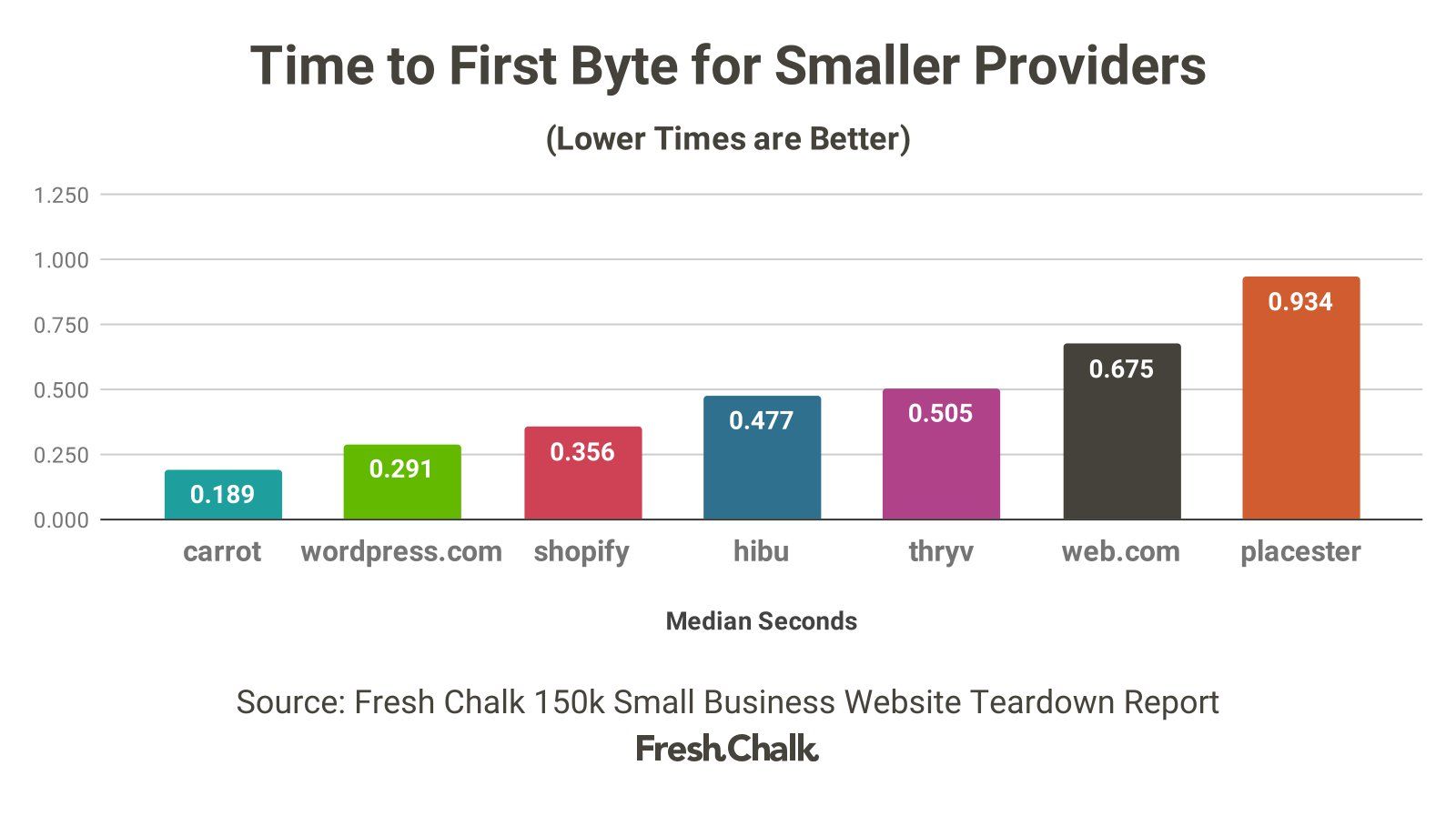
Special shoutout to Carrot, the real estate platform, coming in at a cool 0.189 seconds for median TTFB. They don’t yet have a ton of customers in the grand scheme of things but I just had to include them in the chart. Kudos!
PageSpeed vs TTFB
In the SEO community there’s been plenty of hand wringing over how to optimize websites. Should we pay attention to Google PageSpeed, or monitor TTFB? Google says they use page speed as a ranking factor, but what does that actually mean?
I calculated the correlation between both PageSpeed score and time to first byte against Google rankings. As you may recall from Part One, I was able to determine the Google search rank for 11,000 of the websites in my dataset and used that to make the comparison. I’m no statistician, but I’m perfectly capable of using the CORREL function in Google Sheets:
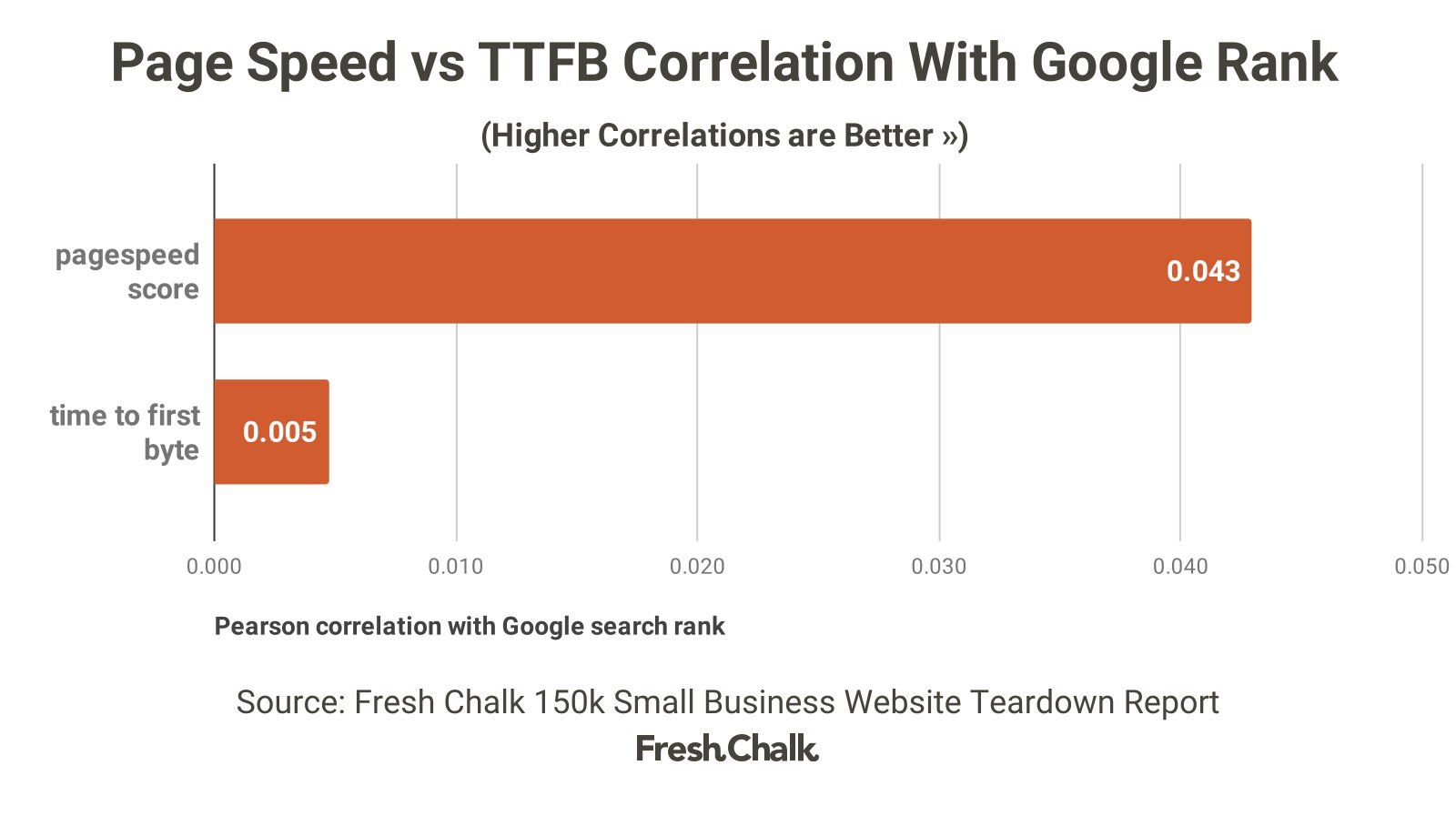
Both of these correlations are slight (close to zero), but clearly PageSpeed correlates better than TTFB. Really, I’m not surprised. Did we think that Google would invest hundreds of man years in the PageSpeed insights tool, API, documentation, evangelism, Chrome speed tools, etc. without making it similar to whatever Google’s search rankings are using?
The Power of Defaults
It’s easy to forget about the power of defaults. As a software creator, it’s my responsibility to build products that usually do the right thing for users even if they are busy, forgetful, or confused. Most of us are busy, forgetful, and confused! Take 401k contributions, for example. Firms that enroll new hires in a 401k plan by default have a 35% higher participation rate, according to a famous study a few years ago.
Does the same maxim apply for out-of-the-box SEO features?
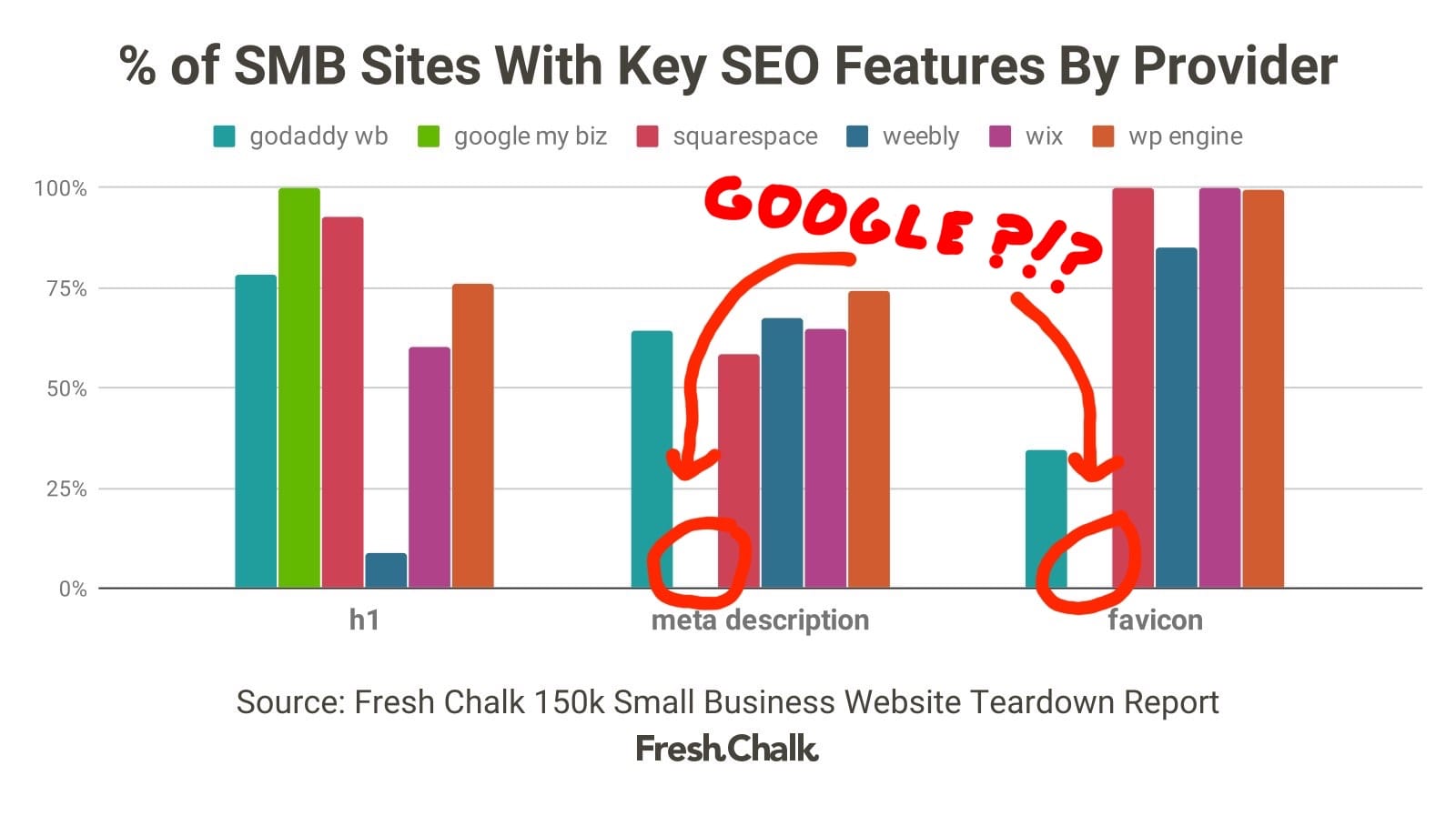
This chart shows how the various large website builders compare for basic features like an h1 tag, a meta description, and a favicon. There’s active debate about how important each individual feature is for ranking, but there’s value in each, even beyond Google’s rankings. Even the humble favicon has risen in prominence now that Google is including it in mobile search results.
Hilarious interlude. Initially, I detected that every Google My Business website had a glorious default meta description. The chart originally had a robust green tower for meta description. But then my astute friend Joy pointed out that she'd never seen a Google My Business site with a meta description.
Joy and I investigated. It turns out that Google My Business sites have a silly meta description formatting bug. Google search can't parse the buggy meta descriptions on Google My Business sites. Can you spot the bug below?
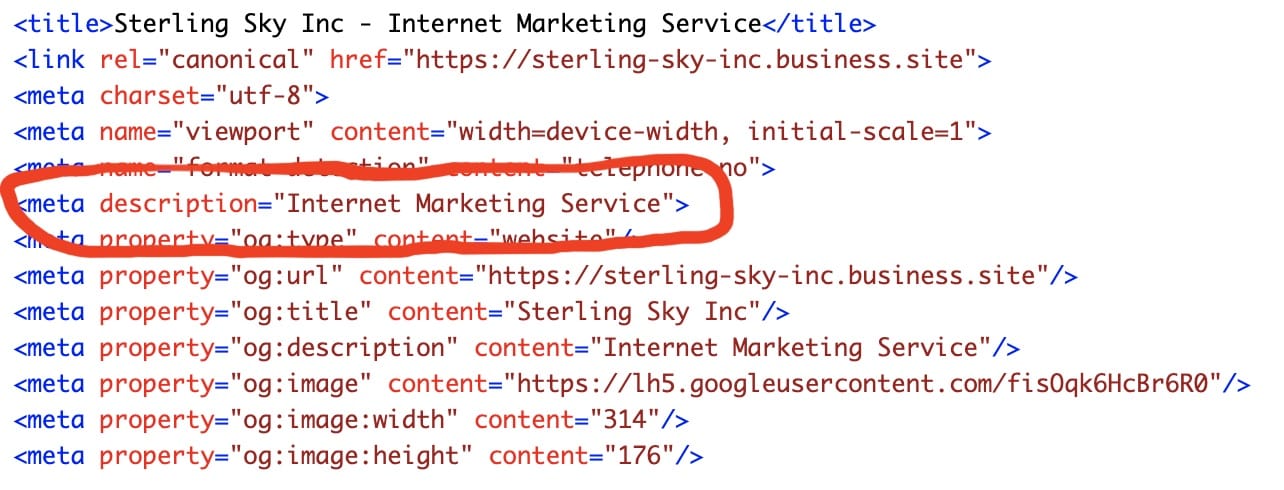
That's not how meta descriptions work. Shall I Google that for you?
Also, Google My Business doesn’t let businesses add a favicon. Nor do they offer a default like Squarespace, Weebly, Wix and WP Engine. I expect that over time this could depress organic rankings on mobile, as users favor sites that have favicons over those that have none.
Some of these Builders Rank Well
We’ve looked at speed, which is a ranking factor. We’ve looked at basic SEO features which affect rank. In Part One, I was able to determine the Google organic search rank for 11,000 of the websites in my dataset. Let’s cut to the chase and examine median Google rank based on the website builder used for each site:
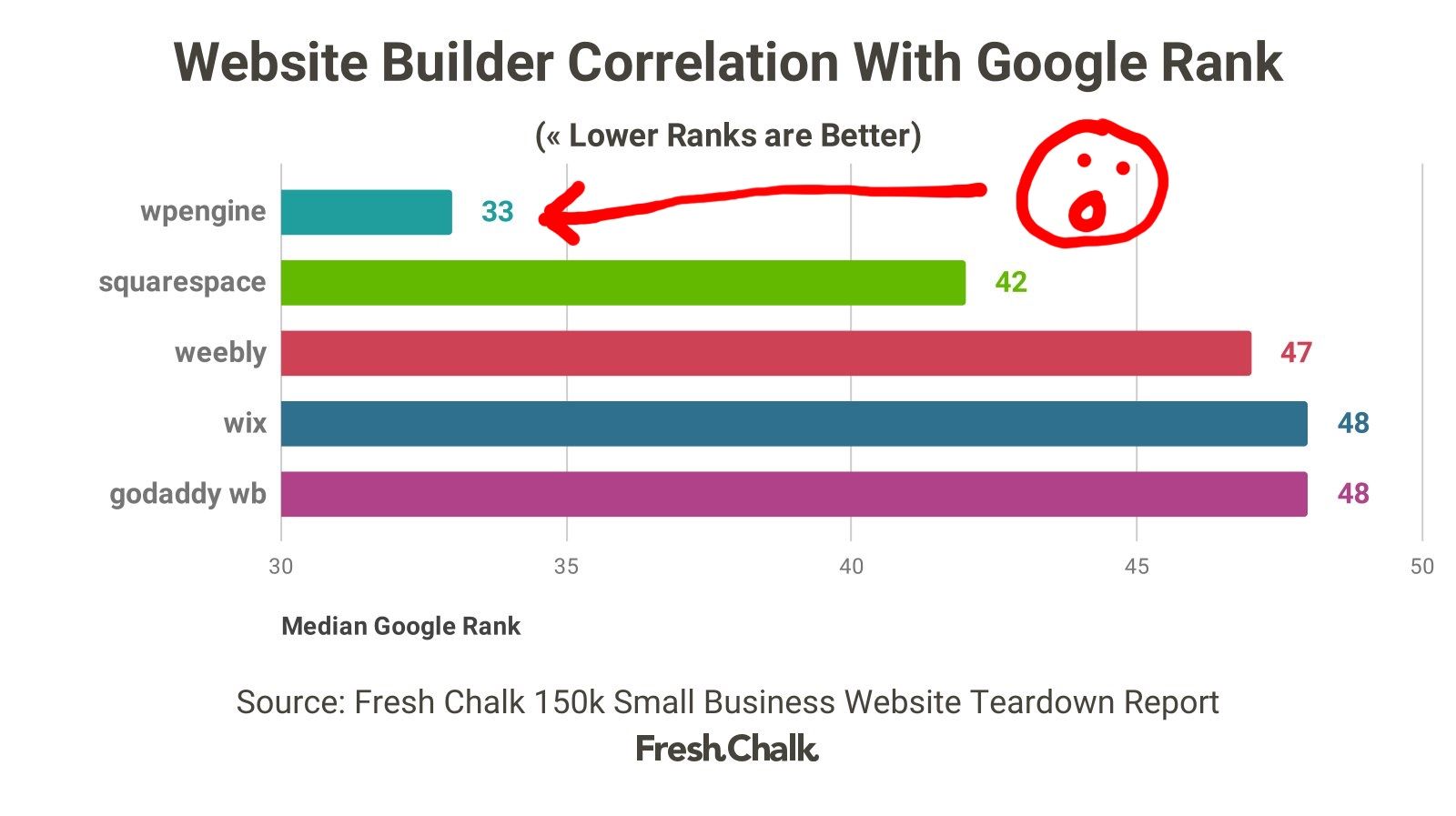
I’ll throw in the caveat that this chart only includes median rank for website builders with enough websites present in organic search. Google My Business, for instance, has very few websites that rank in organic search and therefore isn’t included. I was only able to find a handful, and let’s just say that they did not rank well.
WP Engine is crushing it! The results are undeniable. Websites built with WP Engine tend to rank much better in Google organic search results. Keep in mind that WP Engine has a higher price point than WordPress.com and other budget providers, so there’s some selection bias at work. Still, we are looking specifically at small business websites in this report and there’s definitely something nice happening at WP Engine.
Sites on WP Engine rank a whopping 23% higher than sites with other providers. Squarespace doesn’t seem to correlate with a movement in rank. Websites on Weebly, Wix and GoDaddy tend to correlate with a lower ranking on Google.
Once again, market share does not correlate with superior speed or search ranking!
I have ranking stats for smaller providers but I’ve chosen not to chart them alongside the big players because the data is so sparse. Ping me on Twitter if you want stats for a specific provider. For example, if you sell flowers you should consider using BloomNation because the median Google rank of their websites is 28. I hope to dig into this more in chapter four.
The Sharks - Hibu and Thryv
I was surprised to learn that two digital marketing agencies collectively run 6% of all small business websites in the US. That’s a shocking number. In my ignorance I’d never heard of either of these behemoths. It’s like I was kayaking in tranquil waters and looked over the side to see a pair of great white sharks gliding underneath.
Hibu is a 50-year old UK company with over 12,000 employees that used to be in the Yellow Pages business. In the UK they are known as Yell. These days they call themselves a digital marketing agency, which means they build and market small business websites in exchange for a monthly fee. Thryv is part of Dex, another legacy Yellow Pages company. Dex has a complicated lineage that stretches all the way back to 1886, shortly after the telephone was invented.
Both companies receive a lot of vitriol online. Customers complain that they are locked into high prices for services that don’t generate leads. The contracts can be difficult to cancel and billing mishaps are rampant.
These two sharks forge ahead even as the print directory business continues to wither. Did I mention that Dex recently filed for bankruptcy? For the third time? If you own a small business, there’s a good chance you’ve received sales calls from both of these guys over the years. Should you let them run your website?
Let’s compare against Squarespace, for example:
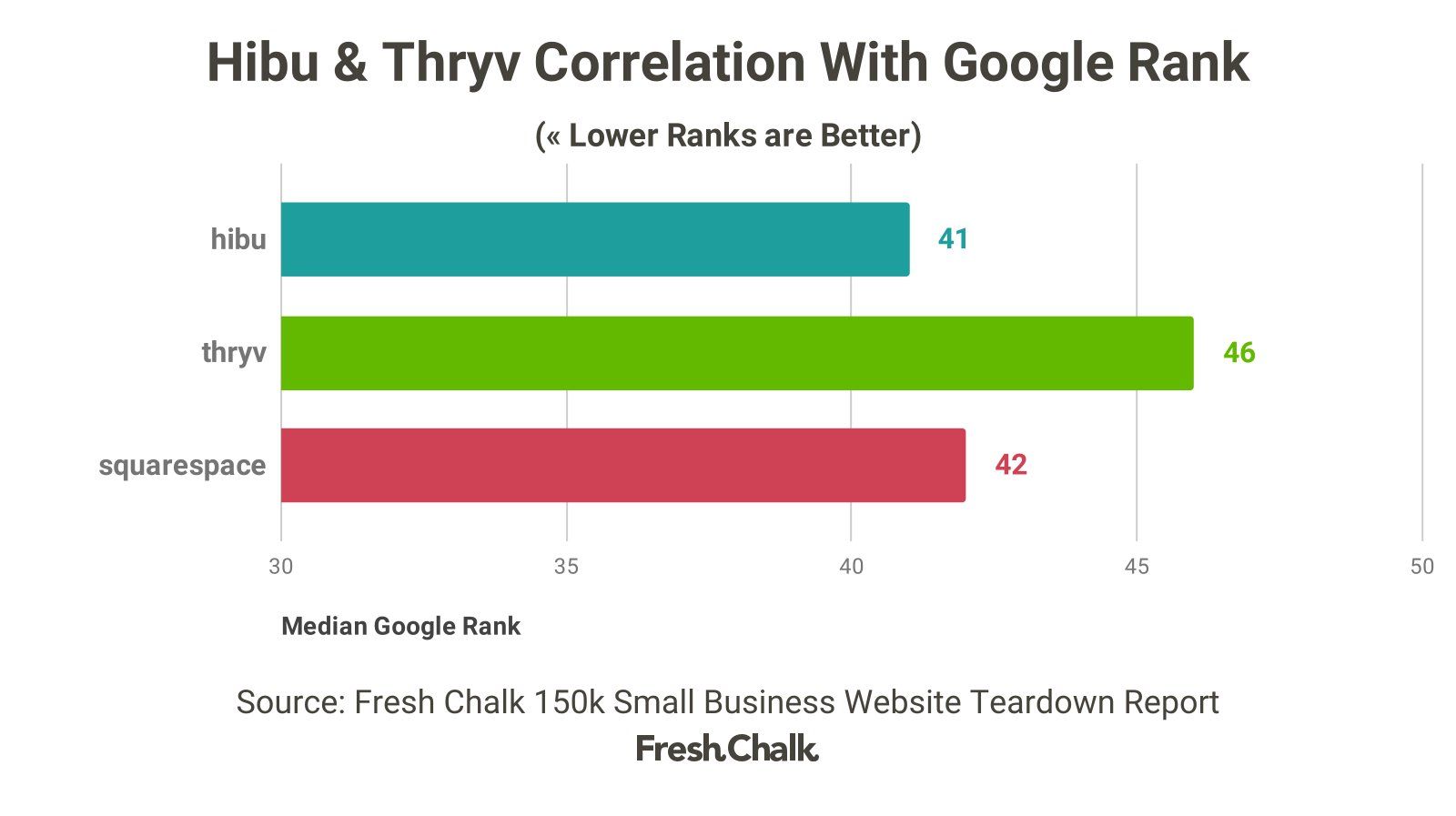
-
-
Hibu & Thryv charge a hefty setup fee to build your website, followed by monthly fees that vastly exceed the cheap plans at Squarespace. Part of the pitch is that they will “handle all the SEO” for your business. For extra cash they will also happily launch ad campaigns, turn on a CRM, and manage your appointments. Hopefully these added services justify the money, because the premium price point isn’t yielding premium Google rankings. They generally rank on par with other popular providers.
At the risk of sounding like a broken record, let me say it again: being a big player in this market doesn’t mean you’re doing right by your small business customers. Hibu and Thryv are just one more example of this sad fact.

Closing Thoughts and Recommendations
This analysis isn’t intended to be a review of website builders, but I feel compelled to make some recommendations. There are clear conclusions we can draw from the data collected herein.
First of all, there’s never been a better time to build your own website instead of hiring a professional. The tools are powerful. It’s easy to create great content and fast websites with decent out of the box SEO, assuming you pick the right website builder.
If I wanted to build a simple small business website, I’d use Squarespace. Squarespace websites tend to rank well in Google. I’d avoid Wix, which ranks poorly and feels slow to users. Godaddy Website Builder is pretty good too, though I can’t come up with a solid reason to recommend it over the others.
I’ll be discussing the WordPress ecosystem in the next chapter, but I already have enough data here to recommend WP Engine for creatingWordPress websites. The price point is a tad high, but WP Engine sites tend to rank really well. That trumps almost all other SMB concerns.
I’d stay away from Hibu and Thryv. These two Yellow Pages relics are desperate for cash and their customers sound unhappy. The websites are expensive and don’t tend to outrank the top website builders. Maybe it’s worth the money if your business wants paid leads without developing any in-house expertise, but I doubt it. Just use a local agency. You’ll get a better website and better service for the same price.
Methodology
Part Two of the report turned out to be a huge project, just like part one. For the main methodology write up, see the Methodology section in Part One.
I detected the host for each of the 150,000 websites examined in this report by searching the HTML for clues. In some cases I also used IP whois queries to trace each website to a specific data center. For example, Weebly is both a full website builder and a CMS used by other hosting providers. For measuring performance I only want websites that are actually hosted by Weebly, so I use whois to track them down.
Many websites contain references to multiple hosting providers and builders. I zeroed in on the websites where I can confidently assign them to a specific website builder. Luckily, this yields strong sample sizes.
I’m sitting on a mountain of unpublished data for SMB websites that run on shared hosting, managed hosting, or in the cloud. I have SMB market share numbers for AWS, Google Cloud and EIG, for example. Maybe I can publish those charts separately.
Google PageSpeed scores were laboriously collected using their API over several weeks due to rate limits. As a pleasant side effect, it should smooth out any temporary slowdowns from the individual providers. I fetched the desktop PageSpeed scores, not mobile. TTFB numbers came straight from curl (after redirects).
Thanks
Chapter Two is officially complete and once again I had a ton of help from friends. Special thanks to Drew Thomas, Joe Heitzeberg, Jono Alderson, Joy Hawkins, Laura Troyani, Mark Maunder, Rand Fishkin & Robbin Block for their assistance putting together this chapter.
The Report is Ongoing
I’ll publish the next chapter in a few weeks. If you’ve got feedback, I'm @adamdoppelt. Let me know if there’s more you’d like to see from this report.
Published
1. SEO
2. Website Builders, Speed and Google Rank (this chapter)
3. WordPress
On Deck
4. The Verticals - Real Estate, Auto, Vision, Chiropractors...
5. Social
6. Technical Factors
